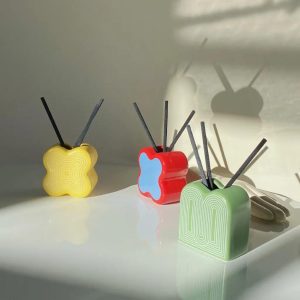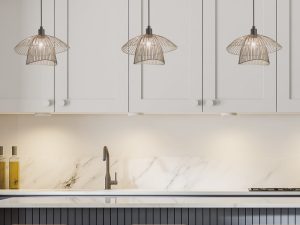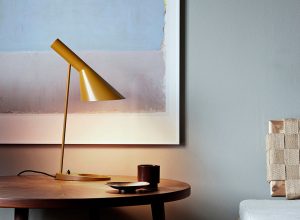Wabi-sabi is a Japanese aesthetic philosophy that finds beauty in imperfection, transience, and the natural cycle of growth and decay. Rooted in Zen Buddhism, this concept encourages an appreciation for the imperfect and the incomplete, celebrating the unique characteristics that come with age and wear. Wabi-sabi invites individuals to embrace simplicity and authenticity, often manifesting in design through organic forms, muted colors, and a focus on natural materials.
This style stands in stark contrast to the modern obsession with perfection and mass production, offering a refreshing perspective that values the story behind each object. In practical terms, wabi-sabi can be seen in various aspects of design, from architecture to interior decor. It often emphasizes asymmetry, irregularity, and a sense of tranquility.
For instance, a handcrafted ceramic bowl with an uneven rim or a piece of furniture that shows signs of wear can evoke a sense of history and character. The philosophy encourages individuals to find beauty in the mundane and to appreciate the fleeting nature of life, making it a deeply personal and introspective approach to aesthetics.
The History of Plaster Fish Line Chandeliers
Plaster fish line chandeliers have a rich history that intertwines craftsmanship with artistic expression. Originating in the mid-20th century, these unique light fixtures emerged as a response to the growing demand for innovative and visually striking designs in home decor. The use of plaster as a primary material allowed artisans to create intricate shapes and forms that were both lightweight and durable.
The fish line aspect added an ethereal quality, giving the illusion that the chandelier was floating in mid-air, enhancing its visual appeal. The evolution of plaster fish line chandeliers can be traced back to the broader movement of mid-century modern design, which emphasized clean lines, organic shapes, and a connection to nature. Designers began experimenting with various materials, and plaster became a favored choice due to its versatility and ease of manipulation.
As these chandeliers gained popularity, they were often featured in upscale homes and galleries, showcasing their ability to blend functionality with artistic flair. Over time, they have become synonymous with elegance and sophistication, often serving as statement pieces in contemporary interiors.
Embracing Imperfection: The Beauty of Wabi-Sabi in Design
The essence of wabi-sabi lies in its celebration of imperfection and the transient nature of life. In design, this philosophy encourages creators and consumers alike to appreciate the unique qualities that arise from natural processes. For instance, a piece of furniture that has been hand-carved may exhibit slight irregularities that tell a story of its creation.
These imperfections are not seen as flaws but rather as marks of authenticity that enhance the object’s character. This perspective invites a deeper connection between individuals and their surroundings, fostering an appreciation for the beauty found in everyday objects. Incorporating wabi-sabi into design also means embracing the passage of time.
Objects that show signs of wear or aging can evoke nostalgia and a sense of history. For example, a weathered wooden table may carry the marks of family gatherings and shared meals, making it more than just a functional piece of furniture; it becomes a vessel of memories. This approach encourages individuals to curate their spaces with intention, selecting items that resonate with their personal stories while also reflecting the beauty of impermanence.
The Unique Aesthetic of Plaster Fish Line Chandeliers
Plaster fish line chandeliers possess a distinctive aesthetic that sets them apart from traditional lighting fixtures. Their sculptural forms often mimic organic shapes found in nature, such as flowing lines reminiscent of water or delicate curves akin to leaves swaying in the breeze. This organic quality not only enhances their visual appeal but also aligns seamlessly with the principles of wabi-sabi, where nature’s imperfections are celebrated rather than hidden.
The use of plaster allows for intricate detailing that can transform a simple chandelier into a work of art. Artisans can create elaborate designs that incorporate textures reminiscent of natural elements like coral or driftwood. When combined with fish line suspensions, these chandeliers appear almost weightless, creating an enchanting atmosphere in any space.
The interplay between light and shadow further enhances their beauty; as light filters through the plaster, it casts soft patterns on surrounding surfaces, adding depth and warmth to the environment.
How to Incorporate Wabi-Sabi Style into Your Home
Incorporating wabi-sabi style into your home involves more than just selecting specific decor items; it requires a mindset shift towards valuing authenticity and simplicity. Start by decluttering your space and removing items that do not resonate with you or serve a purpose. This process allows you to focus on pieces that tell a story or evoke emotion, whether it’s a handmade ceramic vase or a vintage textile with a rich history.
When selecting decor items, prioritize natural materials such as wood, stone, and textiles that show signs of wear or have unique textures. For instance, consider incorporating reclaimed wood furniture that showcases its history through knots and imperfections. Additionally, choose colors that reflect the earth’s palette—soft browns, muted greens, and gentle grays—to create a calming atmosphere.
Layering different textures can also enhance the wabi-sabi aesthetic; think about combining rough-hewn wooden surfaces with soft linen cushions or woven baskets.
The Versatility of Plaster Fish Line Chandeliers in Different Spaces
Plaster fish line chandeliers are remarkably versatile fixtures that can enhance various spaces within a home or commercial setting. In living rooms, they serve as stunning focal points above coffee tables or seating areas, drawing attention while providing ambient lighting. Their organic shapes can complement both modern and traditional decor styles, making them suitable for diverse interior themes.
In dining areas, these chandeliers create an inviting atmosphere for gatherings and meals. The soft glow emitted by plaster diffuses light beautifully, fostering an intimate setting for family dinners or entertaining guests. Additionally, they can be used in bedrooms to add an element of tranquility; their gentle illumination can create a serene ambiance conducive to relaxation.
Beyond residential spaces, plaster fish line chandeliers are increasingly being utilized in restaurants and boutiques, where their artistic flair can enhance the overall aesthetic experience for patrons.
DIY: Creating Your Own Plaster Fish Line Chandelier
Creating your own plaster fish line chandelier can be an exciting project that allows you to express your creativity while embracing the principles of wabi-sabi. To begin, gather materials such as plaster cloth or plaster of Paris, fish line or clear fishing wire for suspension, and a mold for shaping your chandelier—this could be anything from a balloon to a wire frame depending on your desired design. Start by preparing your mold; if using a balloon, inflate it to your desired size.
Cut strips of plaster cloth or mix plaster according to package instructions. Dip the strips into water (if using plaster cloth) or apply plaster directly onto your mold (if using plaster of Paris). Layer the strips until you achieve your desired thickness; remember that imperfections will add character to your final piece.
Once dry, carefully remove the mold and attach fish line for suspension. You can then add light fixtures within the chandelier structure or hang it as an art piece.
Where to Find and Purchase Plaster Fish Line Chandeliers
For those interested in acquiring plaster fish line chandeliers without embarking on a DIY project, numerous avenues exist for purchasing these unique fixtures. High-end home decor stores often carry designer versions that showcase intricate craftsmanship and artistic flair. Online marketplaces such as Etsy feature handmade options from artisans around the world, allowing buyers to support independent creators while finding one-of-a-kind pieces.
Additionally, vintage shops and flea markets can be treasure troves for discovering pre-loved plaster fish line chandeliers with character and history. These venues often offer items at various price points, making it possible to find something that fits both your aesthetic preferences and budget. When shopping for these chandeliers, consider not only their visual appeal but also how they resonate with your personal style and the overall ambiance you wish to create in your space.









